American Sabbatical 014: 9/16/96
Cahokia
9/16.. On the bottom.
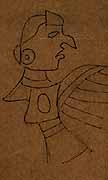
Cahokia Birdman
|
Yesterday we traveled to another time and found one of America’s lost treasures. Kahokia Mounds. We
may fantasize about Flannigan and his barrowfuls of dirt, but
a thousand years ago Mississippian peoples WERE busy erecting
the largest earthen ceremonial structure in the western hemisphere
(two stone pyramids in Yucatan are bigger), and hundreds of lesser
mounds. THIS is the American Bottom. The lowlands just below where
the Missouri joins the Mother of Waters. We had to circle round
to find it, but you know when you get here. |
Now forgotten in the wasteland of East St.Louis, bisected by I-94
and surrounded by industrial artifacts, this great flat heart
of the heartland still has the power to stun the imagination.
Just like at Niagara, we have tried to overlay the power of place
with the power of industry, but all we’ve achieved is a parody
of natural force. Here, in the most unexpected place, is the memory
of a civilization we never learned about in school, and an air
of strangeness that jolts you out of time. It also has the best
museum at an archeological site we’ve ever seen, with knowledgeable
volunteers willing to hike all over the place to fill you in.
From the heartpounding top of the Monk’s Mound, the big one, you
can see the smutch and towers, the great arch of St. Louis across
the water. Here it all is: an ancient civilization now worn down
to hummocks in a green parkland, looking westward through the
metaphoric gateway of another civilization, whose smoke and fumes
will also pass. Being on a big hill after all that flatland makes
you kind of dizzy.
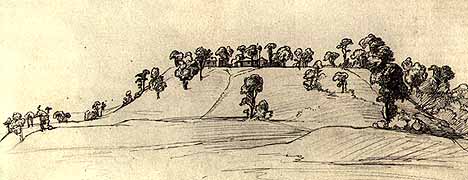
(Monk's Mound 1832 by Carl Bodmer)
(Memo #13)
Sept. 16 - CAHOKIA
Who? Mississippian people (Pre-Columbian Native Americans or "First
People")
What? 20,000 person city of Cahokia - major ritual center
Where? in East St. Louis, Illinois
When? 900-1400 A.D.
How? trade empire (reaching from Florida to Great Lakes, Appalachians
to high plains)
Topics: pre-Columbian sites, Native American Cultures, urbanization,
ceremonial centers, images of Native Americans, moundbuilders,
archaeology. |
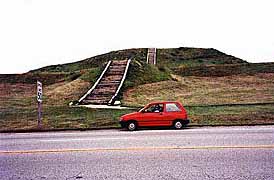
Festiva at Cahokia
|
|
Questions: Where do you find a New World city of perhaps 20,000
people several centuries before Columbus? Where do you find the
largest earthen structure in the western hemisphere, a pyramid
over 100 feet high whose base covers 14 acres? Why do we call
these amazing civilizations "moundbuilder"? |
|
You may have many guesses, I’m betting they’re in Middle or South
America. You may be thinking of the Aztec, Inca, Maya cultures
and places like Chichen Itza, Monte Alban, Teotihuacan. None of
these is the answer. The great mound and the great city I saw
today are Cahokia, a pre-Columbian urban ceremonial center of
the Mississippian people in what is now East St. Louis !!!
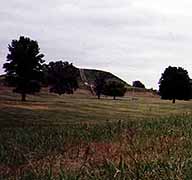
A long view
|
The first impression is of green. The whole huge site is covered
with grass, mounds and great plaza and thousands of house sites
alike. None of the aristocrats’ structures that crowned the great
mound or the myriad thatched homes that formed the city remain.
”I am grass, I cover all”. Long expanses of mowed lawn are broken
by large trees and the shapes of the seventy odd mounds that remain.
Cahokia today almost has the feel of a great groomed park. Yet
even a modern superhighway in the background and a major city
visible from the top of the great mound do not overpower this
site. A huge city was here. You can feel it . |
Walk the huge central plaza from a lesser mound toward the looming
bulk of the great mound. You walk and walk and walk and walk -
a journey across the open field area that was the city heart.
Climb the stairs of the four levels of the great mound and arrive
breathless at the top. Looking south you can see perhaps ten other
smaller pyramids of the seventy odd that remain. Others are hidden
by woods or obscured by modern structures. Looking west you can
see the Mississippi River, the great arch, and the city of St.
Louis far away. On the east a line of hills defines the horizon.
We take heights and views for granted , but what power for people
of a thousand years ago to have gained this view!
Archaeologists have excavated many structures at Cahokia (though
only perhaps 10% of the city’s key sites). They have used their
archaeological findings and the descriptions of European explorers
who described similar peoples (but centuries later) to understand
this site and this culture. Food and crafts and religion and houses
and social structure are all explained in the superb interpretive
center. It has dioramas and demonstrations and a fullscale replica
of a house and a village area that begin to set the modern visitor
in the real Cahokia.
|
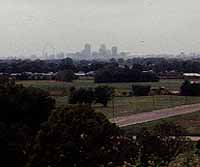
View from the top
|
Cahokia had an open central square, room for a market, and a round
pitch area for chunkey (a ball and spear game). The houses were
thatched-roof wooden square structures, some 8 X 14, others 20
X 20. The platform mounds (one of the three types) had large buildings
on them.
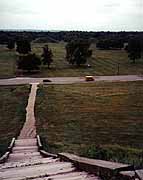
and the other way
|
Cahokia has three kinds of mounds: (1) flat topped or “platform”
mounds that probably held the homes of aristocrats and religious
structures and mortuaries, (2) conical mounds that were burial
sites probably for aristocrats, and (3) ridge topped mounds that
are markers. Four ridge top mounds in fact create a huge diamond
with the points at the four directions. |
Surrounding the main part of the city (about 400 acres) was a
stockade made of an estimated 22,000 tree trunks (oak and hickory)
with guard towers spaced regularly. The trunks were set side by
side about 4 feet deep and stood 12-15 feet high. They formed
a continuous fence that might have been covered with mud “daub”.
West of the great mound was a circle of spaced poles at 12 foot
intervals (now identified with a European name - “Woodhenge”)
that served as an astronomical device and solar calendar (the
central pole aligns with places on the great mound at the equinoxes
and solstices).
| Cahokia was the center of a great civilization that existed from
900-1400AD which combined hunting with effective gardening. Fields
of corn, beans, squash, sunflowers, tubers and many other plants
surrounded the city. The diet also included nuts, berries, wild
animals (especially deer). Stone and bone tools and pottery are
found in abundance. Archaeologists assume that it was a complex
society with different social classes and that the highest leader
lived on top of the great mound. There is evidence of a wide trade
network (sharks teeth from the Gulf of Mexico were found at Cahokia!)
as well as metals from around the great lakes and stone quarried
in many places. |
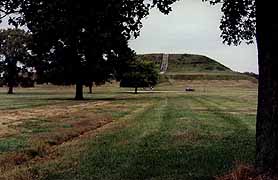
The great mound
|
People wonder about archaeologists. How can they say, for example,
that there was a stockade of poles. You don’t find poles. No,
what you find are clear dark circles in the ground where the poles
rotted. Archaeologists find many clues - from tiny seeds and bits
of bone to bits of pottery, to garbage dumps and dark circles
where poles and fires stood. A technique called flotation uses
water and screens to retrieve tiny bits of plant matter and pollen
from soil from a site. Then laboratory work identifies the remains.
For example, what animal and what parts of the animal bones came
from. Marks on the bones can tell you a lot about food preferences
and butchering techniques.
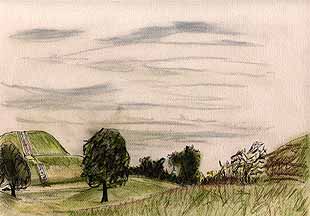
Peggy's Cahokia
|
A whole other topic is the restoration and preservation of the
site, its rescue from the farmers and modern subdivisions that
partially destroyed it. The first Jesuits in the territory built
a chapel on the great mound, a site selected by an eighteenth
century farmer for a house site (he also cut a road into the great
mound for easier access!). In the 1950’s there were rows of tract
housing on the great plaza (now gone). The superb interpretive
center went in on an area they had already excavated.
|
Cahokia has all the hallmarks used by anthropologists to distinguish
true civilization (like Egypt or Mesopotamia or China or Inca):
specialized labor, a food surplus, long distance trade, social
classes, monumental public works, science, high population density,
great art. The only hallmark missing is writing (which the Inca
also lacked). Many other mound sites exist in Alabama, and Iowa,
Illinois, Indiana. Many are national parks. Archaeologists call
the whole civilization the Mississippian - also known as the Moundbuilders
- and have distinguished many different time periods within it. |
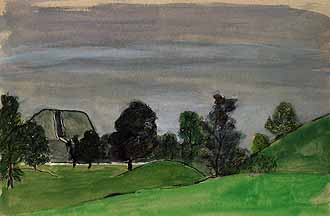
Bryce's Cahokia
|
WHY ISN'T CAHOKIA MORE KNOWN AND VISITED? We told many people
we were going to Cahokia. “Where?” This site may turn out to be
the highpoint of the whole trip - an awe-inspiring and incredible
thousand-year-old city with the grandeur of the Roman forum or
the Greek Acropolis. Perhaps it is that our image of Native Americans
is only teepees and small tribes, not monumental cities. And we
trivialize the creation of huge pyramid by calling them "mounds".
One video I saw explained that 18th century Americans couldn't
cope with the idea of pre-Columbian civilizations in North America
or the possibility that contemporary Native Americans were descendants
of city dwellers.

(Bodmer - 1832)
VISIT !!









